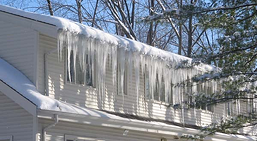Every once in a while in Michigan, we are known to get  some snow. With our varying weather and temperatures, we are at a high risk of getting ice dams. Below are some reasons and solutions to stop Ice Dams before they start.
some snow. With our varying weather and temperatures, we are at a high risk of getting ice dams. Below are some reasons and solutions to stop Ice Dams before they start.
WHAT CAUSES ICE DAMS?
1) Warm air rising to the peak of the attic.
2) Cold air at the lower part of the roof (warm air rises), especially just above the eave where the temperature is about the same as outdoor air.
3) Heavy snow coverage of the roof. This acts as a layer of insulation, preventing heat loss, therefore it makes it warmer in the attic.
When all 3 of these conditions happen, ice dams can form quickly. The heat at the peak of the roof causes the snow to melt and flow to the eave. Since it is freezing at the eave, this melted water refreezes and allows the water to backup and cause ice dams. The damage includes gutter, fascia, landscaping and water infiltration under the shingles. Insulation can become wet, both exterior and interior wall cavities, drywall/paint damage and mold or mildew can form. Some extreme cases can cause ceilings to collapse.
DOES PROPER ATTIC VENTILATION PREVENT ICE DAMS?
Yes it does, especially in Michigan’s climate with snow and frigid temperatures. But, it is also needed in the summer months to keep the attic cool.
There are two main purposes of attic ventilation; to protect against damage to your structure and to reduce energy usage.
A well ventilated attic during the warmer months helps cool the attic down. During the winter it helps to reduce moisture to keep attics dry – which prevents ice dams and mold.
On a hot summer day, the sun hits the roof, travels through the sheathing and heats up the attic space. This heat radiates to the attic floor and into the adjacent living areas raising the temperature. The attic floor can have temperatures as high as 140 degrees (with only 90 degrees outside). Not only does this cost you money in trying to cool the space, but will cause damage to the roof shingles in early deterioration down the road. This can lead to water leaks and expensive roof repair and/or replacement.
In the winter, the warm air from the living areas transfers into the attic and if it isn’t released by ventilation, it can cause problems. This moist air hits cooler rafters, trusses and roof sheathing causing condensation in the form of frost or droplets falling on the materials, which in turn can cause mold and rotted structures.
PRECAUTIONS TO TAKE:
1) Install proper attic ventilation. The most efficient and effective systems use ridge vents and an evenly distributed layout of intake vents.
2) Install proper attic insulation. It prevents heat loss from the living areas and diminishes the energy impact of having cold air flow through the attic.
3) If possible use waterproofing shingle underlayment (WSU) (snow & ice shield) at least 2’ above the interior wall line (would recommend 3’). Valleys should be 3’ on each side of the valley center.
REMOVING ICE DAMS:
First and foremost, be safe. Do not use an axe or ice pick as this can cause bodily injury and/or roof damage. After a good snow fall, remove the snow off the roof with a roof rake. Use a good rake that has wheels at the bottom of the rake to prevent roof damage.
Our recommendation: If it is not safe or is too hard to do, use a professional.

